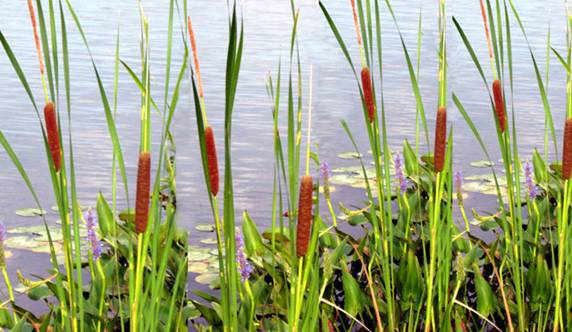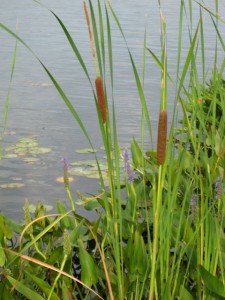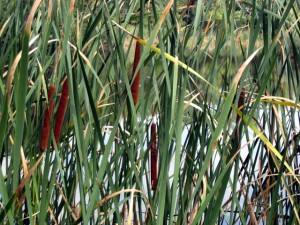08/26/2009 Blue Planet Green Living - From Swamp to Gas Pump ? Cattails Take on New Role
From Swamp to Gas Pump – Cattails Take on New Role
August 26, 2009 by Caryn Green Email: cgreen37@hotmail.com Site: http://www.organicgreenandnatural.com About: See Authors Posts (2)

Cattails add beauty to the landscape. Photo: Caryn Green
Cattails are among nature’s most primitive species. They were here when dinosaurs ruled. They kept baby Moses from floating down the Nile to a premature death. They’re ubiquitous, found in ditches the world over. Grown in clean water, they’re edible. Grown in wastewater, they remove pollutants from the sewage so it can be safely returned to the natural water cycle. In the process, cattails absorb the atmosphere’s increasingly abundant carbon dioxide to fuel photosynthesis, producing sugars and starches that can be converted easily, cleanly, and cheaply into alcohol used for biofuel.
Biofuels solve the same problems that petroleum fuel creates. Plants use the carbon dioxide they remove from the environment to grow. Harvested and converted to alcohol, they return that same energy when used as fuel. This is why corn has garnered a lot of attention as a source of biofuel. But corn-for-ethanol is problematic. Land devoted to growing fuel is land that can’t be devoted to growing food. And, unless it’s grown organically, corn is fertilized with materials that pollute our groundwater and contribute to global warming. Gas-powered tractors harvest it; gas-powered vehicles truck it to market. All this for a fuel source that yields – depending on which study you consult — 75 to 200 gallons per acre? There’s got to be a better way.
Whiskey, Biscuits, and Biofuels

Cattails are hard to eradicate and prevent shoreline erosion. Photo: Caryn Green
The same characteristics that have earned Typha latifolia some bad PR over the years make the common broadleaf cattail an excellent candidate for biofuel production: they’re aggressive and invasive. Once established, Typha is pretty tough to evict, making it effective in combating shoreline soil erosion. It is drought- and fire resistant. It’s able to thrive in both freshwater and brackish, moderately saline swamplands — out-competing other native species that can only live in one or the other. It’s tolerant of wide fluctuation in climatic conditions and water levels, as evidenced by its occurrence from the sub-Arctic to the tropics, and in areas of persistent drought or frequent flooding.
Cattails are often among the first species to gain a foothold in disturbed environments, even when they were not part of the existing vegetation. They were among the earliest plants to emerge after Mount St. Helens erupted. They’re amazingly prolific, propagating both by airborne seed and underground root growth. They don’t require planting or special treatment; they readily grow on unused land, drinking our garbage.
Ancient civilizations recognized the many uses of cattails: The Romans used them to make whiskey. Cattails were a staple of the Native American diet, and our indigenous populations used them for medicinal purposes, building materials — even to make dolls for the kids. More recently, the cattail’s potential as a food and fuel, building material, and source of paper pulp was cited more than 50 years ago, in a December 1955 Science News article. A New York Times article entitled “Cattail biscuits now” reported, “the starchy inner portion of the cattail rhizome makes an excellent flour”; the piece was dated August 8, 1920.
Bioremediation with Cattails

Cattails purify swampy water. Photo: Caryn Green
For some time now, cattails have been used to treat secondary sewage (the oxygen-depleted, nitrate-, ammonia-, and bacteria-laden sludge that remains in wastewater after solids are removed). In 1986, the city of Arcata , California built one of the world’s first sewage treatment wetland facilities. Today, approximately 500 communities are employing cattails in sewage treatment. Able to absorb solids and detoxify dissolved chemicals like mercury, cattails are ideally suited to the task of bioremediation: They even capture and eat organic bacteria through pores on the lower part of the plant.
But, so far, no community is taking the second step — that of harvesting the plants and converting them to ethanol. A cattail’s starch content would put a potato to shame. Its rhizomes — the stout, horizontal stems that grow just below the soil — can contain anywhere from 40–60 percent starch. There’s no general consensus on cattail ethanol yield — different studies using different methodologies have cited anywhere from 1000 to 2500 gallons per acre — but there is universal agreement that cattails represent enormous potential as a bioremediator and fuel source.
Cattail-for-Ethanol Advocates
David Blume, author of Alcohol Can Be a Gas and founder of the International Institute of Ecological Agriculture, consulted on the Arcata Marsh Project. He has been one of the leading advocates of alcohol fuel since the late 1970s.
“Of the 500 or so municipalities that are using cattails for sewage remediation, none are taking advantage of the cattails to process them into ethanol. The original plans for the cattail marsh in Arcata called for the treatment facility to make fuel from the cattail. And they built a test distillery, but by the time the marsh was up and running, gas prices had dropped and they didn’t follow through.”
Blume suggests one of those “the-problem-is-the-solution” remedies in Alcohol Can Be a Gas. “’How about using the roads to provide the fuel for the cars that use them?” Water gathers around roadsides, allowing runoff filled with toxins like herbicides, oil and antifreeze to be carried for miles downstream. “If each county were to cultivate a 5-foot wide strip of cattail on each side of only 1000 miles of county-maintained roads, boom mowers could shred and harvest up to three crops of cattail per year, producing in theory up to 61 billion gallons of fuel (40% of the U.S gasoline consumption — without using a single acre of farmland while also thoroughly detoxifying road runoff water. Planting energy crops in the nation’s unused median strips along divided highways would generate additional billions of gallons.”

Cattails can treat contaminated ground water and serve as a source for biofuel. Photo: Caryn Green
Growing Awareness, Growing Acceptance
Advocates like Blume...are finding support at all levels — from individuals with home distilleries to municipalities, to legislative bodies, to multinational corporations.
“We’ve been working with Senator Russ Feingold (D-WI) to push forward legislation for small-scale ethanol production,” Blume told Blue Planet Green Living. Feingold introduced an amendment to the Farm Security and Rural Investment Act of 2002 to further the adoption of technologies developed by the Department of Agriculture and to encourage small business partnerships in the development of energy through biorefineries. Blume is also encouraged by the introduction of a bill by Senators Tom Harkin (D-IA) and Richard Lugar (R-IN) that calls for 50 percent of all light-duty vehicles manufactured for sale in the United States to be dual-fuel automobiles by 2011.
Ford Motor Company applauds the work being done by Blume and his people. The automaker has come forward with sponsorship money in support of his efforts. After all, Henry Ford never intended to burn petroleum-based fuel in his internal-combustion engine. His Model T ran on ethanol.
The cattail-for-ethanol movement got a huge boost from Congress last year. Overriding a veto from George W. Bush, they passed the Food, Conservation and Energy Act of 2008. Sponsored by Rep. Collin Peterson (D-MN), the bill called for lower tax credits for ethanol produced from corn and other feedstocks, while establishing a credit for production of biofuels from cellulosic matter, such as growing trees, perennial grasses, and agricultural and municipal waste.
In this context, cattails once again lead the way. Cellulose requires complex chemical processing to be converted into sugars and starches, which are then easily fermented into alcohol, while cattails are ready from the get-go.
Flex-fuel Cars Within Everyone’s Reach
Once all this clean, cool home-grown fuel is available, what will it take to adapt our cars to run on ethanol? Not much. Gasoline-burning vehicles require relatively minor software adjustments to the fuel intake program to be able to burn blended fuel.
“It costs about 50 bucks on the assembly line to convert a car to flex fuel,” Blume said. And the cost to convert an existing auto is only a few hundred. You can buy a kit on Blume’s website.
Blume looks forward to increased public recognition that flex-fuel cars are easily within everyone’s reach. Actress-activist Daryl Hannah is going to have one of the conversion kits installed on 9/28, amid, hopefully, lots of press coverage from outlets that do not typically report on environmental issues. Hannah is an ardent supporter of ethanol as fuel and will be at the forefront of a promotional effort to build public awareness on this issue.

The ubiquitous cattail has the potential to solve multiple environmental problems. Photo: Caryn Green
Please report questions or problems with website to webmaster


